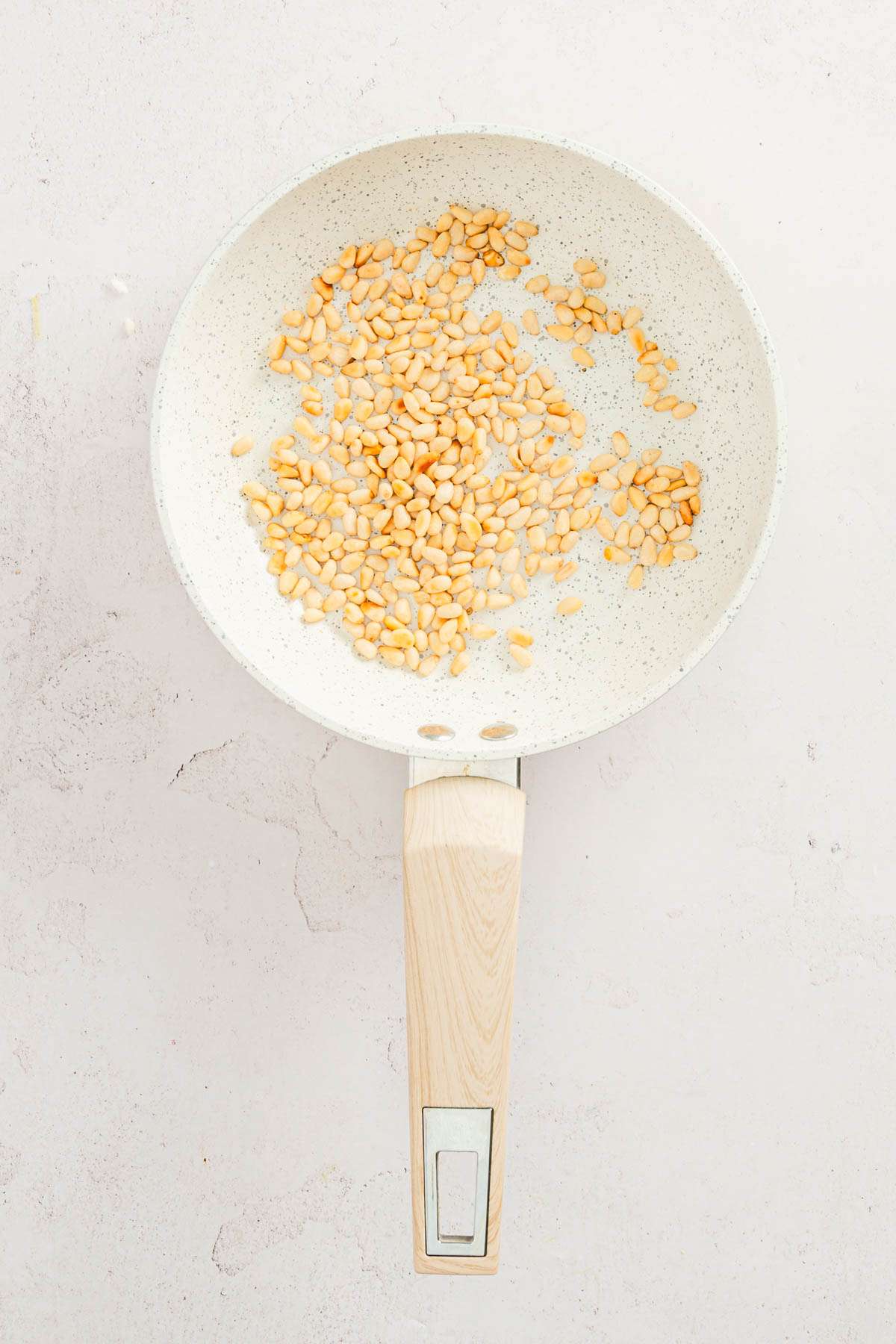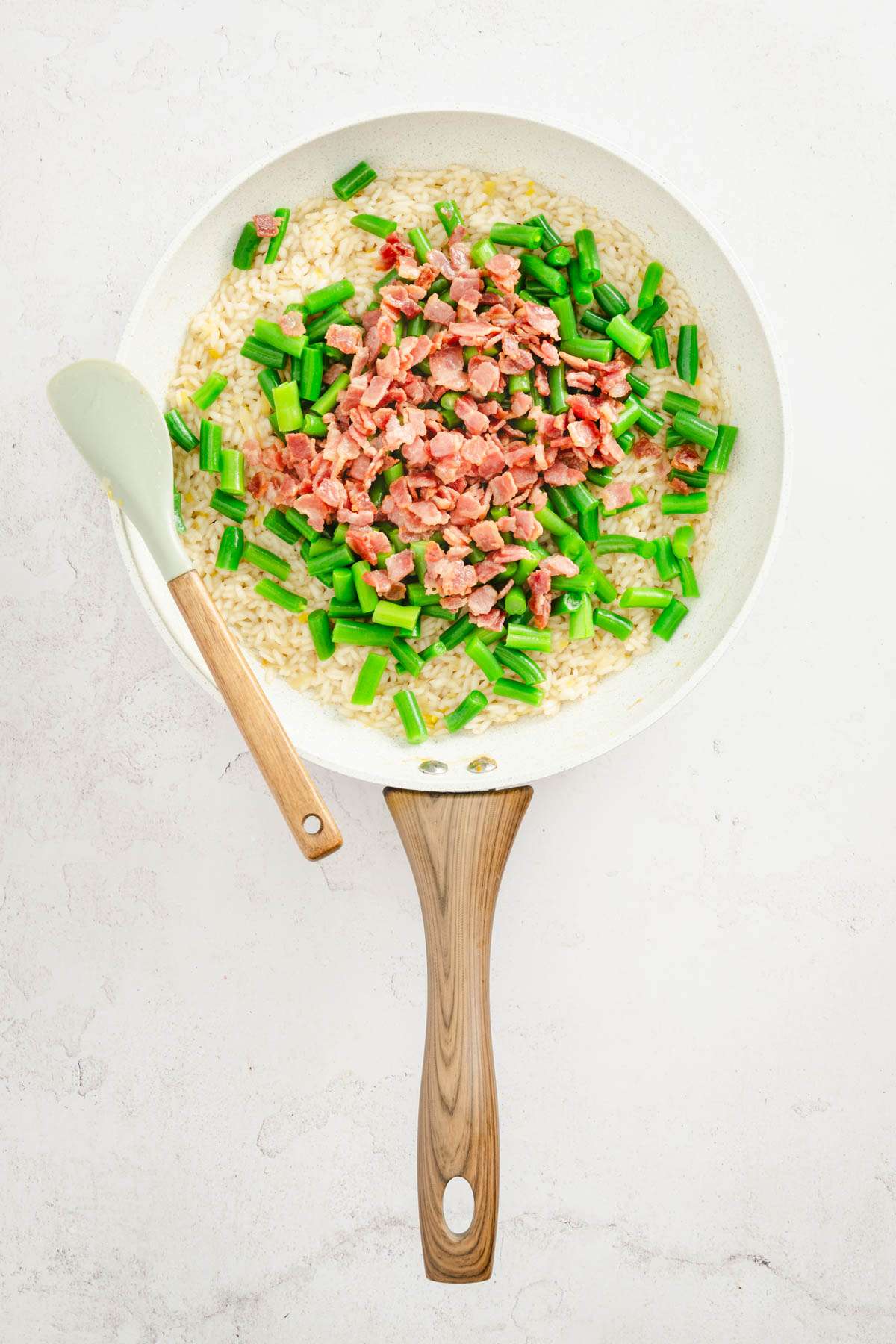Creamy Green Bean Risotto with Bacon
Craving creamy comfort? This Creamy Green Bean, Dill, and Bacon Risotto will deliver just that.
The smooth texture of the Arborio rice, elevated with nutty Parmesan and flavored with bacon, makes this dish rich and satisfying without being heavy.

Fresh green beans and toasted pine nuts add a crunchy texture, while dill adds herbaceous flavor and vibrant green color to this delicious risotto.
It’s a delightful combination!
If this is your first time making Green Bean Risotto, you’ll find this recipe to be both approachable and rewarding.

Why you will love this Green Bean Risotto
Flavors – combining tender green beans, fragrant dill, and savory bacon creates a well-balanced flavor profile. The freshness of the dill brightens the dish, while the bacon adds a satisfying umami depth.
Simplicity – while it’s easy to make, the use of dill and the focus on green beans give it a unique twist that sets it apart from more traditional risottos.
Versatility – this risotto can be served as both a side dish and a main course. Its fresh yet comforting nature makes it perfect for a cozy dinner or as an impressive dish for entertaining guests.
Ingredients, Variations and Substitutions

Fresh Green Beans – provide a crisp texture and fresh flavor. Blanching keeps the beans tender and bright green. Asparagus, snap peas, or fava beans can be a great substitute.
Arborio Rice – a short-grain rice that releases starch, creating the creamy texture of risotto. Stirring frequently helps release the starch for a creamy consistency. Carnaroli or Vialone Nano rice are also excellent for risotto.
Chicken or Vegetable Stock – adds depth and richness to the risotto. Keep it warm on the stove, adding it gradually to the rice. Mushroom broth or mushroom water for a deeper umami flavor, or water with a dash of soy sauce for a vegetarian option.



Bacon – provides a smoky, savory flavor and a bit of crispiness. Cook the bacon until crispy, remove it, and use the rendered fat to sautéing the leeks. Pancetta, prosciutto, or smoked tofu for a vegetarian version.
Leek – adds a mild, sweet onion flavor. Clean leeks thoroughly to remove any dirt between the layers. As an alternative, you can use shallots, onions, or green onions.
Fresh Dill – adds a fresh, slightly sweet, grassy flavor that pairs beautifully with the green beans. Add just before serving to retain its bright color and fresh taste. You can also use fresh parsley, tarragon, or fennel fronds.



Pine Nuts – adds a nutty crunch that contrasts the creamy risotto. Toast lightly to bring out their flavor without burning. Alternatively, slivered almonds, chopped walnuts, or pumpkin seeds can be used.
Dry White Wine – adds acidity and depth of flavor, balancing the richness of the dish. Allow the wine to simmer until it is mostly evaporated to avoid a harsh flavor. If you don’t have any wine, use extra broth with a splash of lemon juice or white wine vinegar.
Parmesan Cheese – adds a nutty, salty flavor that enhances the creaminess of the risotto. Grate fresh for the best texture and flavor. You can also use Grana Padano, Pecorino Romano, or a vegan Parmesan substitute.
Butter – adds richness and helps to emulsify the risotto. Stir in at the end of cooking for a smooth finish. Olive oil or vegan butter are great alternatives.
Fresh Thyme – adds an earthy, aromatic flavor that complements the green beans and dill. For a more subtle taste, use fresh thyme. Dried thyme (use half the amount) or fresh rosemary can also be used.
Lemon Zest – brightens the dish with a fresh citrus note. To avoid bitterness, zest only the outer, colorful part of the lemon skin. Lime zest or a small splash of lemon juice are also great options.
Salt and Pepper – essential for seasoning and bringing out the flavors of the dish. Season gradually, and taste as you go, especially since the bacon and parmesan are salty. For a twist, use flaky sea salt and freshly cracked black pepper, or experiment with smoked salt and white pepper.
Equipment you will need
- Large, Heavy-Bottomed Pan or Dutch Oven
- Medium Saucepan
- Sharp Knife
- Cutting Board.
- Wooden Spoon or Silicone Spatula
- Grater
- Small Bowl
- Colander or Sieve
- Measuring Cups and Spoons
- Ladle
- Small Skillet
- Zester or Microplane
- Tongs

Top Tips for best tasting Green Bean Risotto
Use warm broth – always keep your chicken or vegetable broth warm on the stove while making risotto. Adding cold broth can slow the cooking process and affect the texture of the rice.
Stir constantly but gently – this is a great way to prevent it from sticking to the bottom of the pan. However, don’t over-stir, as this can break down the rice grains and make the risotto mushy. Aim for a balance that keeps the rice creamy but intact.
Add liquid gradually – add the broth one ladleful at a time, allowing the rice to absorb the liquid before adding more. This slow process helps achieve the creamy texture risotto is known for.
Don’t rush – risotto is all about patience. Allow the rice to cook slowly, developing its creamy texture and absorbing all the flavors.
Blanch green beans – blanch them just until they’re tender-crisp, then immediately cool them in ice water to preserve their bright color and prevent overcooking. This step ensures the beans remain vibrant and slightly crunchy in the risotto.
Incorporate fresh herbs – add the fresh dill and thyme towards the end of cooking to preserve their delicate flavors and vibrant green color.
Finish with butter and parmesan – stirring in butter and Parmesan cheese at the end gives the risotto its signature rich and creamy texture. Ensure the risotto is off the heat when adding these ingredients to prevent them from becoming greasy.
Serve immediately – risotto is best enjoyed immediately when it’s at its creamiest. It tends to thicken as it sits, so have everything ready to go and serve it as soon as it’s done.


Step-by-step instructions
- Bring a medium saucepan of water to a boil.
- Trim the ends of the green beans and cut them into 1-inch pieces.
- Blanch the green beans in the boiling water for 2-3 minutes until bright green and tender-crisp.
- Drain them and immediately plunge them into ice-cold water to stop cooking. Drain again and set aside.



- Finely chop the leek, making sure to clean it thoroughly.



- Toast the pine nuts in a small frying pan over medium heat, stirring frequently, until golden brown. Remove from heat and set aside.


- Chop the bacon into small pieces.
- In a large saucepan or Dutch oven, cook the chopped bacon over medium-high heat until crispy.
- Remove the bacon with a slotted spoon and set aside, leaving the rendered bacon fat in the pan.
- Add the chopped leek to the bacon fat in the pan. Sauté over medium heat for about 1-2 minutes until the leek is soft and translucent.



- Add the Arborio rice to the pan with the sautéed leek. Stir to coat the rice in the fat and toast it for about 2 minutes until the edges of the rice become translucent.
- Pour in the white wine, stirring continuously until the rice absorbs it. This will add a depth of flavor to the risotto.
- Begin adding the warm chicken or vegetable broth, one ladleful at a time, stirring constantly. Wait until most of the liquid is absorbed before adding the next ladleful of broth.



- Continue this process for about 18-20 minutes until the risotto mixture is creamy and tender but still has a slight bite (al dente).
- Stir in the blanched green beans and bacon. Cook for 2-3 minutes, allowing the flavors to meld.



- Reduce the heat to medium-low. Stir in the butter, grated Parmesan, and fresh dill until well combined and creamy.
- Season with a pinch of salt and pepper to taste.
- Gently fold in the lemon zest and thyme
- Spoon the risotto into bowls or onto plates.
- If desired, top each serving with toasted pine nuts and a sprinkle of additional fresh dill.
- Serve the risotto hot, enjoying the fresh and savory flavors of the green beans, dill, and bacon.
How to best enjoy this Green Bean Risotto
- Serve it fresh – risotto is best enjoyed fresh off the stove when it’s at its creamiest.
- Pair with a complementary wine – like crisp Pinot Grigio or Sauvignon Blanc.
- Enjoy with a side of green salad
You may also like:
Storage instructions, reheating
- Allow the risotto to cool to room temperature before storing it. This helps prevent condensation, which can make the risotto soggy.
- Place the cooled risotto in an airtight container. If possible, use a shallow container to spread the risotto in an even layer; this helps it cool down faster and reduces the risk of bacterial growth.
- Store the risotto in the refrigerator for up to 3 days.
Reheating Instructions:
- Stovetop Reheating (Preferred Method):
- Transfer the risotto to a saucepan or skillet. Add a splash of chicken or vegetable broth, water, or white wine to help loosen it up and restore its creamy consistency.
- Warm the risotto over medium-low heat, stirring frequently, until it’s heated through and creamy. If needed, add more liquid gradually until the risotto reaches your desired consistency.
- Taste and adjust the seasoning with salt, pepper, or a bit of fresh dill if necessary.
- Microwave Reheating:
- Place the risotto in a microwave-safe dish and add a tablespoon or two of broth, water, or white wine to help rehydrate it.
- Cover the dish with a microwave-safe lid or a damp paper towel to retain moisture.
- Microwave on medium power in 1-minute intervals, stirring in between, until the risotto is heated through. Add more liquid if needed to achieve the desired consistency.
Tips for Reheating:
- Risotto can dry out if overheated, so reheat it gently and gradually.
- If you have fresh dill or toasted pine nuts left over, add them after reheating to brighten the flavors.
- If you prefer crispy bacon, consider frying some fresh bacon separately and adding it on top after reheating the risotto.


Creamy Green Bean Risotto with Bacon and Dill
Equipment
- large pan or Dutch Oven
- medium saucepan to keep the broth warm
- Chef's knife & cutting board
- wooden spoon, spatula
- cheese grater
- small bowl to hold the roasted pine nuts
- measuring cups and spoons
- ladle
- small skillet to cook the bacon and leeks
- zester
- colander and tongs for the blanched green beans
Ingredients
- 1.5 cups fresh green beans blanched
- 1 cup Arborio rice
- 4 cups chicken broth
- 4 slices bacon chopped
- 1 leek finely chopped
- 1/2 cup white wine
- 1/2 cup Parmesan cheese grated
- 2 tbsp butter
- 2 tsp thyme
- 2 tbsp pine nuts
- 1 tsp lemon zest
- Salt and pepper
Instructions
- Bring a medium saucepan of water to a boil.
- Trim the ends of the green beans and cut them into 1-inch pieces.
- Blanch the green beans in the boiling water for 2-3 minutes until bright green and tender-crisp.
- Drain them and immediately plunge them into ice-cold water to stop cooking. Drain again and set aside.
- Finely chop the leek, making sure to clean it thoroughly.
- Toast the pine nuts in a small frying pan over medium heat, stirring frequently, until golden brown. Remove from heat and set aside.
- Chop the bacon into small pieces.
- In a large saucepan or Dutch oven, cook the chopped bacon over medium-high heat until crispy.
- Remove the bacon with a slotted spoon and set aside, leaving the rendered bacon fat in the pan.
- Add the chopped leek to the bacon fat in the pan. Sauté over medium heat for about 1-2 minutes until the leek is soft and translucent.
- Add the Arborio rice to the pan with the sautéed leek. Stir to coat the rice in the fat and toast it for about 2 minutes until the edges of the rice become translucent.
- Pour in the white wine, stirring continuously until the rice absorbs it. This will add a depth of flavor to the risotto.
- Begin adding the warm chicken or vegetable broth, one ladleful at a time, stirring constantly. Wait until most of the liquid is absorbed before adding the next ladleful of broth.
- Continue this process for about 18-20 minutes until the risotto mixture is creamy and tender but still has a slight bite (al dente).
- Stir in the blanched green beans and bacon. Cook for 2-3 minutes, allowing the flavors to meld.
- Reduce the heat to medium-low. Stir in the butter, grated Parmesan, and fresh dill until well combined and creamy.
- Season with a pinch of salt and pepper to taste.
- Gently fold in the lemon zest and thyme
- Spoon the risotto into bowls or onto plates.
- If desired, top each serving with toasted pine nuts and a sprinkle of additional fresh dill.
- Serve the risotto hot, enjoying the fresh and savory flavors of the green beans, dill, and bacon
Notes
Nutrition
Did you make this recipe?
Tag me @sylwiavaclavekphotography or tag me using #myomnikitchen so I can see your creations! You can also leave a comment below!
Conclusion
This Green Bean Risotto recipe with bacon and dill is a comforting yet elegant dish that beautifully captures the essence of late summer and early fall.
The combination of tender green beans, aromatic dill, and crispy bacon, all wrapped up in a creamy risotto, creates a hearty and fresh meal. Perfect for a cozy dinner, this Green Bean Risotto will impress your taste buds with its balance of flavors and textures.
Whether you’re enjoying it with family or serving it at a gathering, this dish will surely be a crowd-pleaser. Pair it with a crisp white wine for the ultimate dining experience!


FAQ about Green Bean Risotto
Can I make this risotto ahead of time?
Risotto is best enjoyed fresh, but if you need to prepare it ahead, slightly undercook the rice and finish it just before serving. Reheat gently with a little extra broth or water to regain its creamy texture.
Can I use frozen green beans instead of fresh ones?
Yes, you can use frozen green beans. Just thaw them and pat them dry before blanching. Fresh green beans will give the best texture and flavor, but frozen is a convenient alternative.
What can I use instead of bacon?
If you prefer a vegetarian version, omit the bacon and add a splash of olive oil for richness. You can also try using pancetta or prosciutto for a different flavor profile or smoked tofu for a vegetarian option.
How do I keep the risotto from becoming too thick?
Risotto thickens as it cools. To keep it creamy, add extra broth or a bit of warm water when reheating, stirring it to achieve the desired consistency.
Can I use a different type of rice?
Arborio rice is traditional for risotto because of its high starch content, giving the dish a creamy texture. Carnaroli or Vialone Nano rice can also be used. Long-grain rice won’t provide the same creamy result.
Is it necessary to use white wine in the risotto?
While white wine adds a depth of flavor, you can substitute it with additional broth or a splash of lemon juice for acidity. However, using wine is recommended for its complexity.
Can I freeze leftover risotto?
Risotto doesn’t freeze well, as the texture changes and becomes less creamy. Enjoying it fresh or refrigerated for up to three days is best.
What can I serve with this risotto?
This risotto pairs well with a simple green salad, crusty bread, or a light vegetable side dish. You can also serve it as a side dish alongside grilled chicken or fish.
How can I add more protein to this dish?
For more protein, you can add grilled chicken or shrimp or even stir in some cooked beans like cannellini or chickpeas.
How can I make this dish dairy-free?
To make a dairy-free version, use a dairy-free butter alternative and omit the Parmesan cheese. Nutritional yeast can be used as a cheesy substitute.








